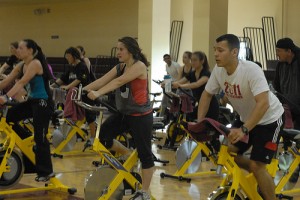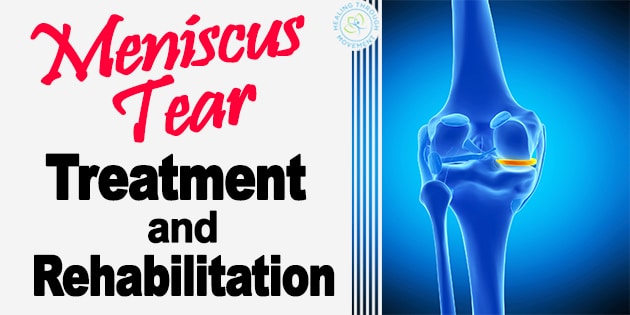Welcome to this article on meniscus tear.
Enjoy the article and make sure to read to the end if you would like to look at the other parts to this article on meniscus tear and meniscus tear exercises.
Meniscus Tear Treatment and Rehabilitation
There are certain factors that should be considered when creating your meniscus treatment plan. Your physician will base your treatment and rehabilitation plan on the type of meniscal tear that you have, size of the tear, area of the meniscus involved, your age, your level of activity, and other related injuries.
Degree of healing is highly dependent on the location of your meniscus tear. Recall that not all areas of a meniscus receive adequate supply of blood, which carries the nutrients required for tissue healing. The outer one-third of the meniscus is sufficiently supplied with blood. In contrast, the inner two-thirds of the meniscus is poorly supplied with blood. A tear in this part of the meniscus may not be treated conservatively. A surgical procedure may be recommended.
Conservative treatment
If your meniscus tear is small and found on the outer region of the meniscus, a conservative treatment is most likely to be recommended by your physician. In cases of tears with good prognoses, a meniscus tear exercise program will be sufficient to manage the meniscus injury.
RICE Protocol for a Meniscus Tear
The Rest, Ice, Compression, and Elevation protocol, or RICE protocol, is recommended to clients. The RICE protocol aims to minimize the swelling, reduce the pain, normalize the gait, encourage normal range of motion of the knee, prevent muscle wasting, and maintain proprioception (Baker, 2011). Adherence to this treatment plan is a must to ensure adequate healing of the damaged meniscus:
- Rest and Activity Modification – The first but frequently overlooked treatment strategy is taking a break from the activity that led to the injury, from activities that can lead to worsening of the tear or increasing symptoms. The pain has a function. It informs your body to rest and stop performing the activities that may aggravate the condition. It is strongly encouraged to avoid, be cautious of, or modify squatting, kneeling, heavy lifting, climbing, and running during acute painful episodes.
- Ice – Application of ice is essential during recovery. Cold constricts the blood vessels, leading to reduced swelling and redness. Ice may also numb the nerves around the area of the injury, decreasing the pain. It is recommended to apply ice 15 to 20 minutes at a time, several times a day, during the first 24 to 48 hours after the injury. Wrap the ice in a towel to decrease the risk of causing contact burns on the skin. Application of heat is only recommended 48 hours after the injury. Heat may exacerbate the condition by increasing joint swelling and pain.
- Compression – Wrapping the knee in elastic bandages helps drain the fluid accumulated in the injured area. Using the correct compression technique reduces swelling and provides support and protection for the injured knee.
- Elevation – Elevating the involved knee above the level of the heart drains the excess fluid that has accumulated in the injured site.
Medication for a Meniscus Tear
 Intake of certain medications can also help reduce pain during the recovery stage. You may take analgesics like acetaminophen and non-steroidal anti-inflammatory drugs, such as ibuprofen, naproxen, diclofenac, and celecoxib, to control minimal to moderate pain. Prior to taking any medication, consult with your physician or pharmacist.
Intake of certain medications can also help reduce pain during the recovery stage. You may take analgesics like acetaminophen and non-steroidal anti-inflammatory drugs, such as ibuprofen, naproxen, diclofenac, and celecoxib, to control minimal to moderate pain. Prior to taking any medication, consult with your physician or pharmacist.
Your physician may prescribe oral or intramuscular narcotic analgesics if the pain becomes intolerable or if you fail to respond to analgesics and NSAIDs. These drugs are only used sparingly during the conservative treatment period.
Surgical Procedures for a Meniscus Tear
If the signs and symptoms of meniscus injury are not resolved by conservative management, your physician may recommend a surgical procedure to manage the injury. A surgical intervention may also be recommended if the injury causes locked knee.
The meniscus has essential functions, and its removal is not the first choice when surgery is being considered.
Not all tears respond to surgery. Tears with good chances of healing with surgery are repaired through arthroscopy. Arthroscopy, a minimally invasive procedure, is the standard of surgical care. Compared to partial removal of the meniscus, arthroscopy offers better long-term outcomes.
Partial meniscectomy may be recommended if your tear occurs in the region of the meniscus where the supply of blood is not adequate. This procedure is also recommended if your tear is not amenable to repair through arthroscopy.
Exercises for Meniscus Injuries
Exercises are vital when treating, recovering, and preventing meniscal injuries. It is highly recommended that you have an effective rehabilitation program that will help you regain and maintain strength and flexibility of your knee, like Meniscus Tear Solution.
Before exercising, it is important to use the right footwear and clothes. It is also essential to perform warm up exercises before the exercise session and cool down exercises after the exercises to prevent further injuries or aggravating the condition.
Exercises During the Acute Meniscus Tear Stage
During the acute stage or initial phase of rehabilitation, complete immobilization of the knee is discouraged. Ankle pumps and gentle range of motion exercises of the knee are first recommended to facilitate adequate flow of blood, which facilitates healing. These simple and non-stressful exercises may also prevent complications, such as stiffening of the knee.
After 48 to 72 hours of the injury or surgery, you may perform quadriceps sets, straight leg raises, and hamstring sets. These isometric or static exercises help prevent muscle wasting and loss of strength and function of the affected knee.
Overall, the initial stage includes exercises that aim to overcome limitations to range of motion. Flexibility exercises for the lower extremities, including the quadriceps, hamstrings, hip flexors, hip adductors, and calf muscles, must be initiated. Passive flexion ROM exercises, such as wall slides, are also included.
These exercises are also recommended as you progress:
- Isotonic strengthening exercises of the hamstring muscles
- Hip abduction strengthening
- Toe raises
- Stationary bicycling
Keep in mind to limit your activities during the acute stage. Avoid, limit, or modify squatting, kneeling, heavy lifting, climbing, and running.
Exercises During Intermediate Meniscus Tear Phase

Exercises recommended during the intermediate phase are only initiated if you have achieved full or near full range of motion. Flexibility and strengthening exercises performed during the initial phase are continued with added resistance, as tolerated. It is also during this stage where you can start performing isokinetic strength exercises and endurance training.
Closed kinetic chain exercises may be initiated as soon as the quadriceps is strong enough to resist the load. Running in place on a trampoline is gradually introduced into the program. Jogging for 10 to 15 minutes can be started, once the knee demonstrates absence of swelling and pain.
Exercises During Advanced Meniscus Tear Phase
As you make your progress, your physical therapist may order the initiation of strength-training exercises. Sport-related activities can be started.
Exercises for the Prevention of a Meniscus Injury
Exercises that build strength and flexibility of your knee and leg are effective in preventing future injuries. After achieving recovery, the exercises discussed previously must be continued to avoid or delay degeneration of the knee.
If you have a meniscus injury or were recently diagnosed with this condition, twisting of the knee and walking on an uneven train is discouraged. Wear the right footwear and learn the right techniques in cutting, slowing down, pivoting, and landing from a jump.
Thank you for reading.

Rick Kaselj, MS
If you liked the above, you might find these posts helpful:
- What To Do About Meniscal Injuries?
- What Causes a Meniscus Tear?
- Signs and Symptoms of a Meniscus Tear
- Terminal Knee Flexion for Knee Injury Recovery
- Avoiding Common Terminal Knee Extension Exercise Mistakes
.

